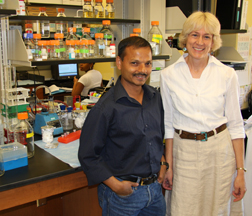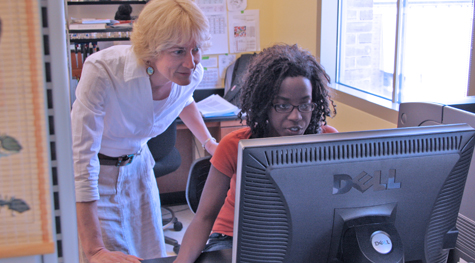Studying cellular 'traffic control'
The grant was announced through the office of Congressman Rob Wittman of Virginia’s 1st District. Allison’s lab has had continuous funding for this work since 2001—from the National Science Foundation as well as from NIH.
“Nuclear,” in this case, refers to the cell’s nucleus, where genetic information
 is stored, and not to nuclear energy. Allison’s work concerns the thyroid hormone receptor, a protein “messenger” that shuttles between the cell’s two major components, the nucleus and the cytoplasm. The thyroid hormone receptor, Allison explained, is an essential protein that regulates the turning on and off of genes in the nucleus, in response to thyroid hormone.
is stored, and not to nuclear energy. Allison’s work concerns the thyroid hormone receptor, a protein “messenger” that shuttles between the cell’s two major components, the nucleus and the cytoplasm. The thyroid hormone receptor, Allison explained, is an essential protein that regulates the turning on and off of genes in the nucleus, in response to thyroid hormone.“Our interest is in how this protein gets to where it needs to be in order to function and, in certain disease situations, how is it mislocalized,” Allison said. “The thyroid hormone receptor is made in the cytoplasm—that’s where proteins are synthesized—and it needs to go into the nucleus to interact with the DNA and to regulate particular genes.”
About eight years ago, Allison discovered that the thyroid hormone receptor not only moves into the nucleus, but also moves back to the cytoplasm. Understanding just how thyroid hormone receptor exits the nucleus is the focus of the NIH grant, she said.
“It doesn’t just go in and stay there and bind to DNA and regulate genes like everyone had thought for decades. It shuttles between the nucleus and the cytoplasm,” she explained. “We still don’t really understand the physiological significance of that, but it means that we started looking for mechanisms about how it gets into the nucleus and then we discovered we also had to study how it gets out.”
Allison’s study of intracellular “traffic control” is important to the greater understanding of how a number of DNA-related diseases work. She explained that some cancer cells, for instance, show that they have more of the thyroid hormone receptor in the cytoplasm, as opposed to the nucleus.
“So if you have something wrong with the import and export properties of the thyroid hormone receptor—then it can end up mostly in the cytoplasm, which means of course that it can’t function,” she said.
Allison’s lab is in William & Mary’s new Integrated Science Center. She is assisted by post-doctoral researcher Manu Mavinakere, lab manager Vinny Roggero and a number of William & Mary students.
 Skip to main content
Skip to main content

